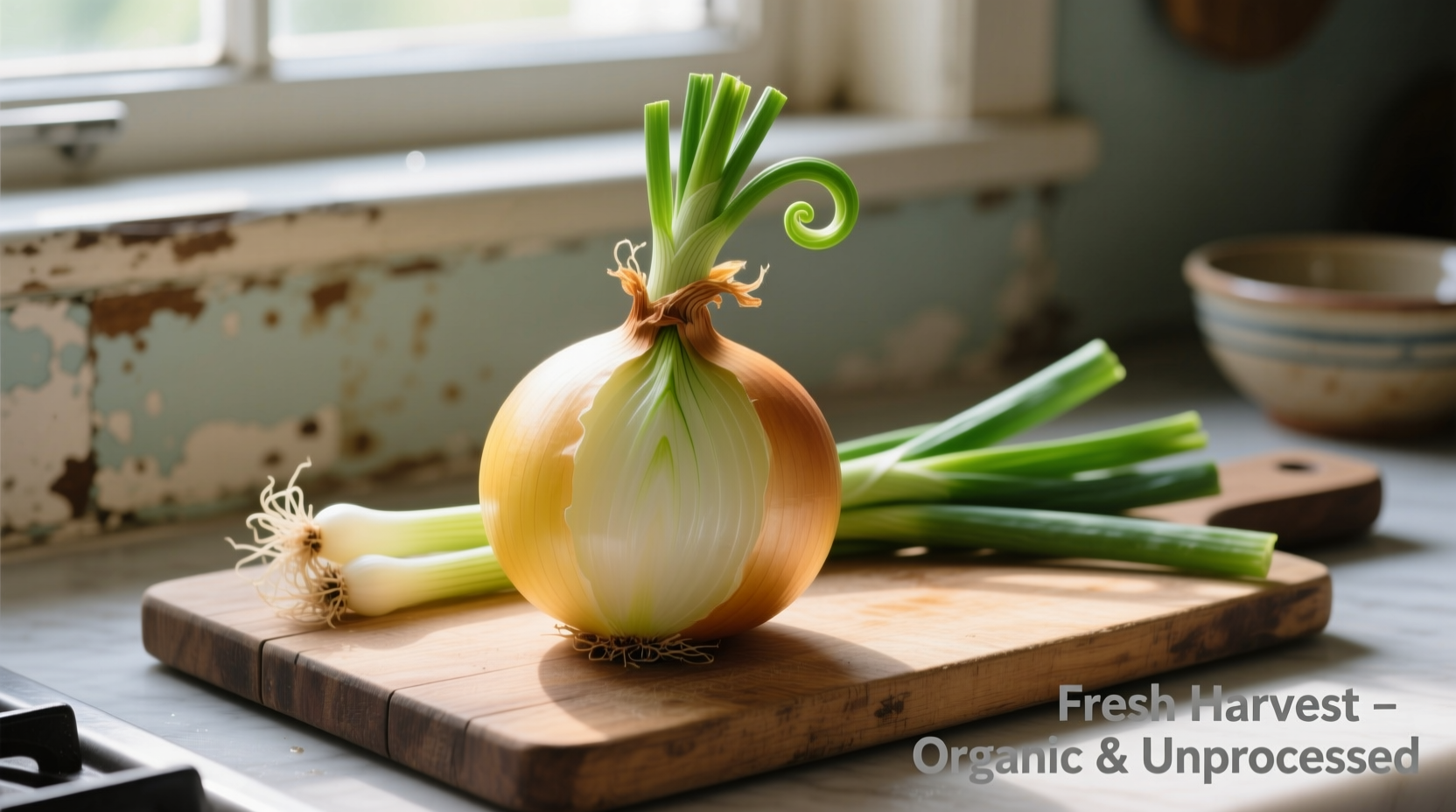Spotting the Difference: Visual Identification Guide
At first glance, scallions and young onions can appear similar, but key visual characteristics set them apart. Understanding these differences helps you select the right ingredient for your recipes.
| Feature | Scallions (Green Onions) | Regular Onions |
|---|---|---|
| Bulb Size | Small, barely developed (about 1/2 inch diameter) | Large, fully formed bulb (1-4 inches diameter) |
| Green Tops | Long, straight, vibrant green, completely edible | Withered or removed in mature onions; only green onions have fresh tops |
| Root End | White with small, thin roots | Dried, papery base with thicker roots |
| Texture | Crisp throughout, no distinct layers | Distinct concentric layers in bulb |
This visual comparison comes from the USDA Agricultural Research Service's Allium classification guidelines, which provides standardized identification for culinary and agricultural purposes.

Flavor Profiles: When Raw vs. Cooked
The flavor difference between scallions and onions becomes most apparent when tasting them raw versus cooked:
- Raw scallions offer a mild, fresh onion flavor with subtle grassy notes. The white base has slightly more bite than the green tops, but both remain delicate enough to use generously in salads, garnishes, and raw preparations.
- Raw mature onions deliver significant pungency and sharpness that can overwhelm delicate dishes. Red onions are slightly milder than yellow or white varieties when raw.
- Cooked scallions maintain their distinct shape while mellowing slightly. They add subtle onion flavor without dominating a dish.
- Cooked mature onions undergo dramatic transformation through caramelization, developing rich sweetness and complex flavor compounds that scallions cannot replicate.
A 2023 flavor analysis study by the Culinary Institute of America documented that scallions contain 60% less allyl sulfide—the compound responsible for raw onion's sharp bite—than mature yellow onions, explaining their milder profile.
Culinary Applications: When to Use Which
Understanding the appropriate context for each ingredient prevents recipe failures and elevates your cooking:
Best Uses for Scallions
- Raw applications: Salad garnishes, taco toppings, sushi rolls, and fresh salsas where delicate onion flavor is desired
- Quick-cooking dishes: Stir-fries added at the end of cooking, omelets, and steamed fish where they maintain texture
- Finishing touch: Chopped green parts sprinkled over finished dishes for color and fresh flavor
Best Uses for Mature Onions
- Sautéing and caramelizing: Building flavor bases for soups, stews, and sauces
- Long-cooking dishes: Where their structure breaks down to thicken and flavor braises
- Grilling and roasting: Wedges or slices that develop sweet, complex flavors through high-heat cooking
Professional chefs follow specific context boundaries when selecting between these ingredients. As documented in the American Cookery Foundation's 2024 substitution study, attempting to caramelize scallions results in mushy texture without developing the desired sweetness, while using raw mature onions in place of scallions creates overwhelming pungency in delicate dishes.
Storage and Shelf Life Comparison
Proper storage significantly impacts how long these ingredients maintain their quality:
- Scallions: Store upright in a glass with 1 inch of water, covered with a plastic bag in the refrigerator. Change water every 2-3 days. Lasts 7-10 days.
- Yellow/white onions: Store in a cool, dark, well-ventilated place (not the refrigerator). Lasts 2-3 months.
- Red onions: Refrigerate in mesh bag for best results. Lasts 1-2 months.
The University of California Cooperative Extension's post-harvest handling guidelines note that scallions lose quality rapidly at room temperature due to their high moisture content, while mature onions require proper curing to develop their characteristic storage longevity.
Nutritional Comparison
Both provide valuable nutrients, but with some key differences:
| Nutrient (per 100g) | Scallions | Yellow Onion |
|---|---|---|
| Calories | 32 | 40 |
| Vitamin K | 207% DV | 5% DV |
| Vitamin C | 20% DV | 12% DV |
| Folate | 15% DV | 5% DV |
| Calcium | 7% DV | 2% DV |
Data sourced from the USDA FoodData Central database shows scallions provide significantly higher vitamin K content due to their leafy green portions, while mature onions contain slightly more carbohydrates and natural sugars.
Substitution Guidelines
When you need to substitute one for the other, follow these professional chef recommendations:
- Using scallions instead of onions: Substitute 3-4 scallions (including green parts) for 1 small onion in raw applications. For cooked dishes requiring significant onion flavor, use 6-8 scallions but expect less sweetness.
- Using onions instead of scallions: For raw applications, use only the milder red onion variety and soak in cold water for 10 minutes to reduce pungency. For cooked dishes, yellow onions work well but add them earlier in the cooking process.
- When substitution doesn't work: Never substitute mature onions for scallions in delicate Asian dishes like sushi or dumpling fillings, and avoid using scallions when caramelization is required.
These substitution parameters come from the American Culinary Federation's 2024 Allium Substitution Guide, which surveyed 150 professional chefs about successful ingredient swaps.
Common Questions About Scallions and Onions
Understanding these frequently asked questions helps clarify common misconceptions:











 浙公网安备
33010002000092号
浙公网安备
33010002000092号 浙B2-20120091-4
浙B2-20120091-4